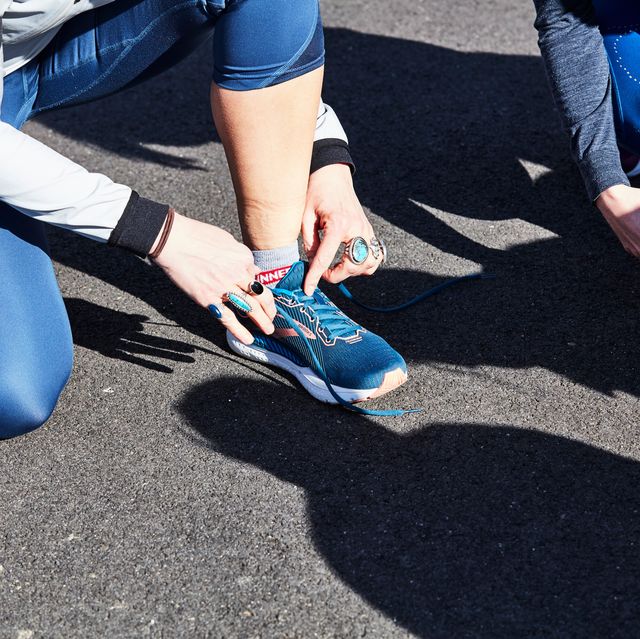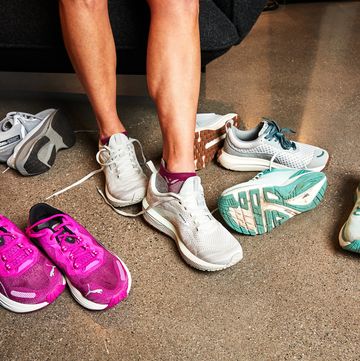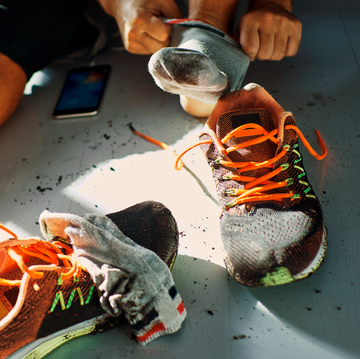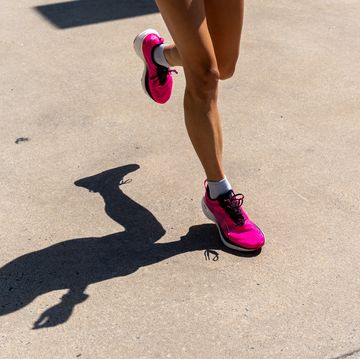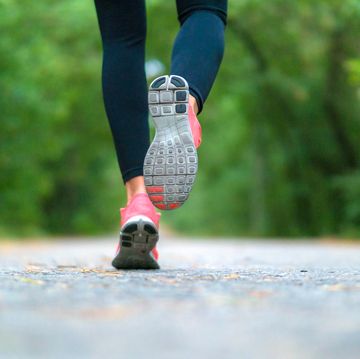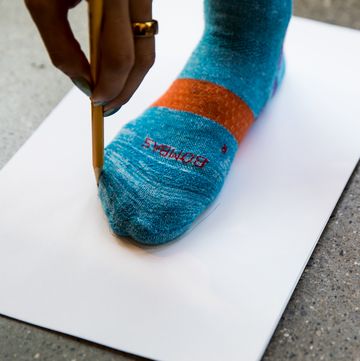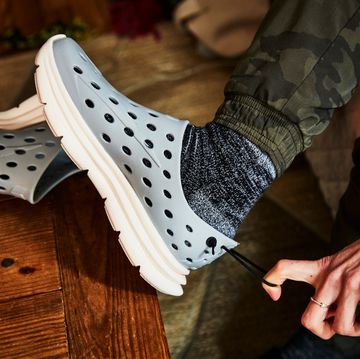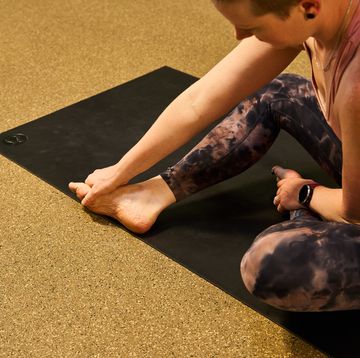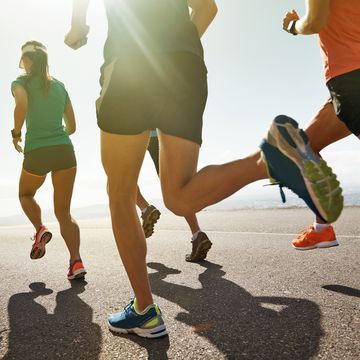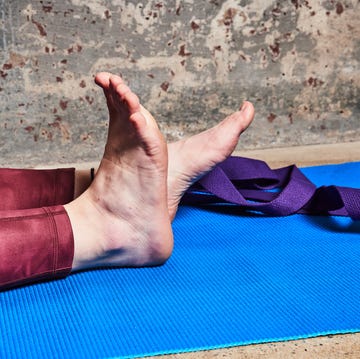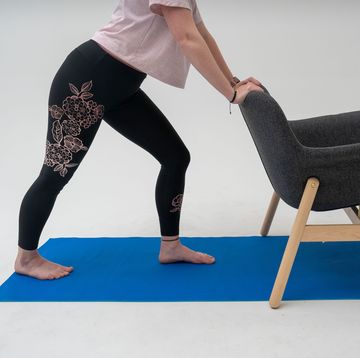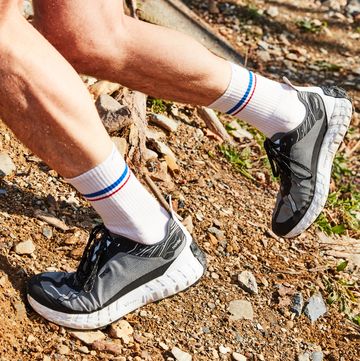Picture this: You’re blissfully clocking your miles on a Saturday morning until you feel a small but growing pressure on top of your foot. It’s slight, so you ignore it, but over time that discomfort starts to become more noticeable—and once you take your running shoes off at home, you notice a bulb-like bump on your foot.
What gives? You could have what’s known as a ganglion cyst. These sometimes painful bumps aren’t often talked about in the running community, but they’re one of the most common soft tissue masses found in the foot and ankle, per a 2023 review in the Journal of Clinical Orthopaedics and Trauma. Plus, they can derail your training if not addressed.
Here’s everything you need to know about ganglion cysts as a runner, including how to prevent and treat them.
How might a ganglion cyst show up in runners?
A ganglion cyst develops slowly over weeks or months, but it may grab your attention during a run.
“There will be some soreness associated with a ganglion during a run due to shoe pressure against it,” says Karen A. Langone, D.P.M., a Southampton, New York-based spokesperson for the American Podiatric Medical Association and podiatrist who specializes in sports and fitness medicine. “You might notice a lump on the foot, which can worsen during the run.”
That lump on your foot can be easy to confuse with a number of other conditions. Found along a tendon or near a tendon, a ganglion cyst can be mistaken for an exostosis, for example, which is a benign (noncancerous) bone tumor, per the Cleveland Clinic.
“It might also be confused with a stress fracture of a metatarsal bone,” says Alex Kor, D.P.M., a spokesperson for the American Podiatric Medical Association, a podiatrist at Hendricks Regional Health in Danville, Indiana and team podiatrist for the athletic programs at Butler University. A metatarsal stress fracture is a break in the bone from repeated injury or stress, which can be caused by running.
What is a ganglion cyst?
On the other hand, ganglion cysts are noncancerous bumps that usually appear along your tendons or the joints of the wrists or hands, but they can also occur in ankles and feet, according to the Mayo Clinic. They’re filled with a jellylike fluid.
“A ganglion cyst, like any mass, makes the runner’s foot feel tight,” says Kor. “The pain can be characterized as dull or sharp if mileage is extended or there is increased shoe pressure.”
This cyst is usually caused by a bony point that’s exacerbated by shoe pressure (and possibly by your foot swelling at the end of a run), a tendon that gets overused (which may be the result of tendonitis), or from acute trauma. The fluid in the tendon sheath can “leak out” after overuse or trauma to form the ganglion cyst, adds Kor.
Once one of these things occurs, the inflammation within the tendon sheath accumulates in one area and worsens, forming the ganglion cyst.
Although they’re filled with fluid, they can feel firm to the touch, per Yale Medicine. They can be as small as a pea or as large as an inch in diameter. Sometimes, they can affect joint movement and cause pain if they press against a nerve.
The majority of ganglion cysts occur on the top of the foot or the front of your ankle, says Kor. They are rare on the bottom of the foot.
Risk factors for these cysts include sex and age (most often, ganglion cysts occur in women between the ages of 20 and 40) and osteoarthritis (particularly when they occur in the hands), per the Mayo Clinic.
Should you run with a cyst?
You can continue to run with a ganglion cyst, especially if there is no pain. Even if there is some pain, your level of discomfort will determine the best steps for treatment.
“This is not a condition that will significantly worsen [if you run on it],” says Kor. “In other words, it is not like a stress fracture that can ‘break’ to the point that surgery is needed.”
However, it’s important to check with a doctor to make sure the bump is a ganglion cyst and not something more serious, and to determine ways to avoid discomfort.
Being a runner alone does not increase your risk of ganglion cysts, but your foot shape may play a role. “They are a little more common in very high arched feet and very flat feet,” says Kor.
How can runners treat ganglion cysts?
First, visit your doctor, who may conduct imaging tests like an X-ray and ultrasound to confirm that it is a ganglion cyst (and not something else).
Once the bump has been identified as a ganglion cyst, there are a few treatment options, starting with these less invasive methods:
Padding
This can be placed around (not on) the ganglion cyst to avoid pressure from a running shoe. “A pad or blister bandage directly over the ganglion cyst may worsen the pain,” says Kor. “Typically, a horseshoe pad or donut pad is applied to offload the cyst.”
Icing
You can also ice your foot after a run and on a daily basis for 20 to 30 minutes. Place a towel between your foot and the ice pack to avoid skin irritation. “Ice can cause vasoconstriction to reduce inflammation, swelling, and pain,” says Kor.
Changing Shoes
A supportive shoe has the potential to reduce overuse, which may help in the initial stages of a ganglion cyst, says Kor. A supportive shoe should not bend at the sole (typically, this has nothing to do with the brand name or price of the shoe).
Taking Breaks from Footwear
When you’re not running, avoid shoes that exacerbate the ganglion cyst area. For instance, skip the one-strap sandal that directly rubs the cyst area. Unsupportive footwear, like flip-flops with a flexible sole, can also worsen the cyst.
Adjusting Your Shoe Laces
If the ganglion is on the top of the foot, your shoelace pattern can be changed to avoid direct pressure on the ganglion. For instance, your podiatrist might recommend a lacing pattern often used for patients with high instep (the bony structure on top of your foot).
In this case, cross your laces as usual toward the bottom of the tongue, skip crossing them over in the middle (and instead create a line along each side of the tongue), then finish lacing near the top of the tongue. This offloads the top of the foot that may be affected by the cyst. See an example of how to do it here.
Take Anti-Inflammatory Medication
If approved by your doctor, you can take over-the-counter anti-inflammatory medications to ease the discomfort of a ganglion cyst.
If you’re in pain, it’s worth speaking with your doctor about longer-term solutions for treating the cysts. Kor notes that many runners may see little to no improvement with these conservative options.
If these steps don’t help, your podiatrist might suggest an in-office procedure in which the fluid is withdrawn and sometimes injected with a small amount of cortisone to shrink the remaining cyst—or complete surgical removal of the cyst.
Even surgery isn’t a magic bullet: The recurrence of ganglion cysts after surgical removal ranges from 4 to 40 percent, according to a 2021 study in The Archives of Bone and Joint Surgery.
Clearly, it’s important to speak with your doctor transparently about your pain levels to determine the pros and cons of each treatment. Fifty percent of the time, ganglion cysts resolve on their own, according to a historic study in Current Reviews in Musculoskeletal Medicine.
How can runners prevent ganglion cysts?
Some of the methods described above for treating an early-stage cyst can also be used to prevent one in the first place, starting with your running shoe.
“Ganglions are often found over areas where the bone is prominent and there is aggravation from shoe pressure,” says Langone. “A well-fitting running shoe is an important part of avoiding ganglions, as is altering lacing patterns to avoid painful pressure.”
If your doctor has already aspirated your ganglion cyst and you want to prevent recurrence, a well-fitting shoe and altering lacing patterns may still help—along with icing after runs.
“Over-the-counter or custom-made orthotics can also indirectly help with a ganglion cyst,” says Kor. “There is some indication that increasing support within the shoe can reduce the overuse on a tendon, which may in turn reduce the irritation that contributes to a cyst.”
Your podiatrist can prescribe custom orthotics based on your foot’s specific shape. That said, if a ganglion cyst is already significantly symptomatic, an over-the-counter orthotic will typically not help.
As with most things, prevention and early detection are key. If you start to notice discomfort or an unusual bump, make an appointment with your doctor to discuss treatment options—so you can get back to pain-free miles.
